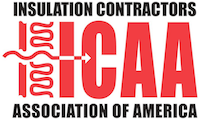
When batt insulation is installed above suspended ceilings, the installations should conform to the fire safety requirements of the prevailing building code. In many commercial jobs, however, code officials approve insulation applications that do not conform to the prevailing building code.This bulletin addresses and recommends practices known to conform to the requirements of the International Building Code and to all three model building codes including the: National Building Code (BOCA); Uniform Building Code (ICBO); and Standard Building Code (SBCCI).
All requirements for exposed applications of insulation for the three model codes are similar and agree to the following conditions:
- Insulation, including facing, shall have a Flame Spread Index = 25 or less and a Smoke Developed Index = 450 or less when tested per ASTM E 84 or UL®723. Standard foil-faced and kraft-faced batts do not conform to the requirements of any model code for exposed applications. Their facings have Flame Spread Indices greater than 25.
- The only acceptable application of standard foil-faced and kraft-faced batts is when the product shall be behind, and in substantial contact with, an approved ceiling construction material as required by the building codes. Substantial contact means that most of the facing surface of the insulation touches the approved ceiling construction material. Neither inset nor face stapling excludes the substantial contact requirement. If substantial contact is not maintained and an open plenum results between the installed batt insulation and an approved non-combustible ceiling construction material, then an exposed application results.¹ In this case the proper vapor retarder facing material shall have a flame spread index of 25 or less; i.e., FSK (Foil Scrim Kraft) and/or FSP (Foil Scrim Poly).
- A flame spread rated facing installed over kraft, standard foil or other non-rated facing does not meet code.
- Poly-wrapped batts usually meet Flame Spread Index = 25 or less, but lack the tear resistance and durability recommended for commercial exposed applications.
¹ Kraft facing is unacceptable in any part of the building in Types 1 and 11 construction. ICBO requirement for Types III, IV, and V construction is consistent with this interpretation. SBCCI and ICBO both provide for concealed application allowing a flame spread of up to 75, but the conditions of a “concealed” space are not defined. Most manufacturers print a fire warning label on both kraft and standard foil requiring substantial contact for proper application, making the interpretation above correct when a space results.


